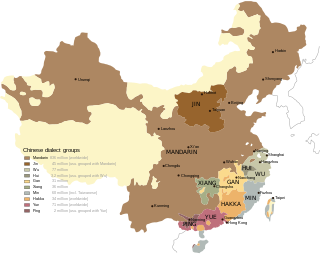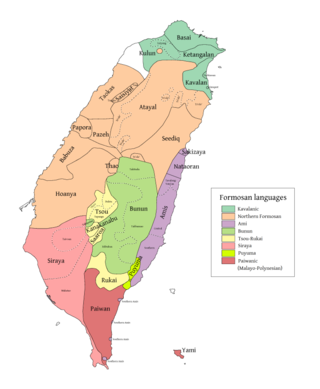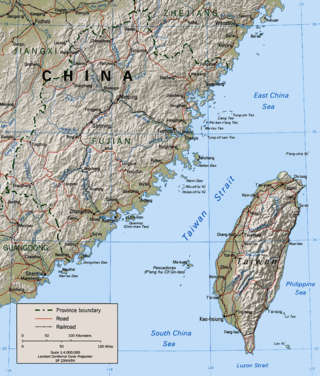
The Sinkang Manuscripts are a series of leases, mortgages, and other commerce contracts written in the Sinckan, Taivoan, and Makatao languages. Among Han Chinese, they are commonly referred to as the "barbarian contracts". Some are written only in a Latin-based script, considered the first script to be developed in Taiwan itself, while others were bilingual with adjacent Han writing. Currently there are approximately 140 extant documents written in Sinckan; they are important in the study of Siraya and Taivoan culture, and Taiwanese history in general although there are only a few scholars who can understand them.

The Sinitic languages, often synonymous with the Chinese languages, are a group of East Asian analytic languages that constitute a major branch of the Sino-Tibetan language family. It is frequently proposed that there is a primary split between the Sinitic languages and the rest of the family. This view is rejected by a number of researchers but has found phylogenetic support among others. The Greater Bai languages, whose classification is difficult, may be an offshoot of Old Chinese and thus Sinitic; otherwise Sinitic is defined only by the many varieties of Chinese unified by a shared historical background, and usage of the term "Sinitic" may reflect the linguistic view that Chinese constitutes a family of distinct languages, rather than variants of a single language.
Seediq, also known as Sediq, Taroko, is an Atayalic language spoken in the mountains of Northern Taiwan by the Seediq and Taroko people.

The Civil Human Rights Front (CHRF) was an organisation that focused on the issues of Hong Kong politics and livelihood, affiliated with almost all pan-democratic camps in Hong Kong. It was founded on 13 September 2002 and disbanded on 15 August 2021.

The Seediq are a Taiwanese indigenous people who live primarily in Nantou County and Hualien County. Their language is also known as Seediq.

Tatsuo Nishida was a professor at Kyoto University. His work encompasses research on a variety of Tibeto-Burman languages, he made great contributions in particular to the deciphering of the Tangut language.

Sakizaya is a Formosan language closely related to Amis. One of the large family of Austronesian languages, it is spoken by the Sakizaya people, who are concentrated on the eastern Pacific coast of Taiwan. Since 2007 they have been recognized by the Taiwan government as one of the sixteen distinct indigenous groups on the island.
Chen Cheng-jia is a Taiwanese politician. He currently serves as the Administrative Deputy Minister of the Council of Indigenous Peoples of the Executive Yuan. He is a Han Chinese.
The writing systems of the Formosan languages are Latin-based alphabets. Currently, 16 languages have been regulated. The alphabet was made official in 2005.
Indigenous Areas are the administrative divisions in Taiwan with significant populations of Taiwanese indigenous peoples. These areas are granted higher level of local autonomy. Currently there are 55 such divisions.

Kolas Yotaka is an Amis Taiwanese politician and journalist. From 2020 to 2022 and again in 2023, she served as spokesperson for the Office of the President under Tsai Ing-wen. Kolas previously served as spokesperson for the Executive Yuan in 2018, the first Taiwanese aboriginal to hold the position.
Philosophy in Taiwan is the set of philosophical traditions in Taiwan, while Taiwanese philosophy is taken to mean philosophical work from the country. Philosophical thought in Taiwan is diverse, drawing influence from Chinese philosophy during Qing rule from the 17th and 18th century, and Western philosophy through the Kyoto School during Japanese rule in the 19th and early 20th century. Taiwanese philosophy took a more endogenous turn during the modern era, with burgeoning philosophical debate regarding Taiwanese Gemeinschaft.

Wu Li-hua, known in the Rukai language as Saidhai Tahovecahe, is a Taiwanese Rukai educator and politician. She is the first legislator of the Democratic Progressive Party to represent the Highland Aborigine Constituency, to which she was elected in 2020.

The Fujian–Taiwan relations, also known as the Min–Tai relations, refers to the relationship between Fujian, which is located in mainland China, and Taiwan, which is across the Taiwan Strait. Since the average width of the Taiwan Strait is 180 kilometers, Fujian and Taiwan are adjacent, similar in both climate and environment. Although the relationship between Taiwan and Fujian has changed with the development of history, the two places have maintained close relations in terms of personnel, economy, military, culture and other aspects. At present, Taiwan residents are mostly descendants of immigrants from mainland China, of which the southern Fujian ethnic group is the main group, accounting for 73.5% of Taiwan's total population. In terms of culture, language, religion, and customs, Fujian and Taiwan also share similarities.

NDHU College of Indigenous Studies is a school of Indigenous Studies at National Dong Hwa University (NDHU). Founded in 2001, it traces its root back to the Graduate Institute of Ethnic Relations and Cultures in 1995 with Professor Chiao Chien, the Professor of Anthropology at Indiana University Bloomington and Founding Chair of Anthropology at Chinese University of Hong Kong, as Founding Director.
The Sakuma Foundation's Indigenous Artifacts Collection Project was a large-scale systematic acquisition program for the collection of artifacts of the indigenous peoples in Taiwan under Japanese rule. Between 1927 and 1929, the Sakuma Foundation was responsible for funding the acquisition of 1,760 artifacts from Taiwanese indigenous peoples, which were acquired by the Indigenous Pacification Section of the Department of Police of the Government-General of Taiwan.
Haku, whose Chinese name is Chen Wen-sheng, is a Puyuma artist and chief of the Kasavakan community in Taitung. He is a wood sculptor and icon of Taiwanese Indigenous artists.
Hu Tai-li was a Taiwanese anthropologist and documentary director from Taipei. She graduated from Taipei First Girls' High School, obtained her bachelor's degree in history from National Taiwan University, and later earned her master's and doctoral degrees in anthropology from the Graduate Center of the City University of New York.
Moon Night Sorrow is a popular Taiwanese Hokkien song, which takes its tune from the music of the Plains indigenous peoples of Taiwan. It was composed during the Period of Japanese Rule in Taiwan by Deng Yuxian, with lyrics by Zhou Tianwang (周添旺). It was first performed in public by Lin Shihao (林氏好), and recorded by Columbia Records on a record, which was released in 1933.
Hakka popular music is a genre of popular music composed and performed in the Hakka language, also known as modern Hakka music. It is mainly prevalent in Malaysia, Taiwan, Indonesia, and Guangdong, with Taiwanese Hakka popular music being the most vibrant and developed.











